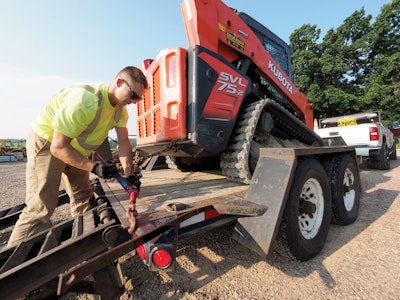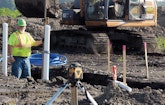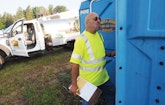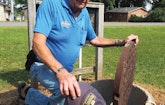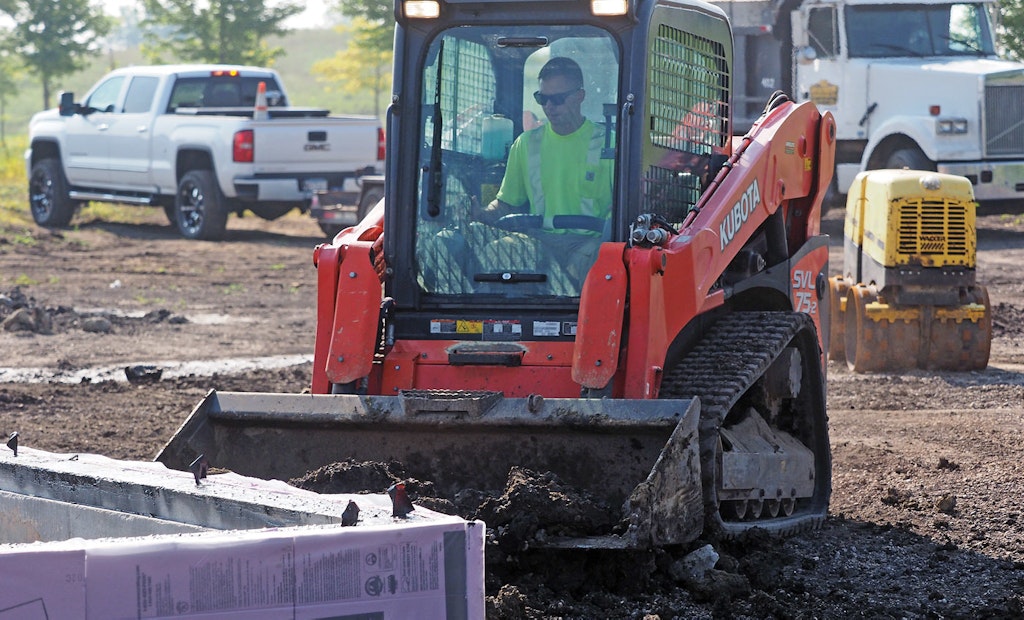Minnesota is known as the Land of 10,000 Lakes, and a fair number of those are scattered across the countryside near Eagle Lake, Minnesota, where J.R. Bruender Construction is located. The high water table around the lakes adds its own challenge to the company’s installation business.
J.R. Bruender Construction overcomes that challenge as it has overcome others. About half a century after it was started by John R. Bruender, the company is still going strong. Bruender is “retired,” but still helps with projects. His son Steven Bruender runs the company, and Steven Bruender is planning for the transition to his 24-year-old son Joshua.
There are nine employees, and although the word “construction” is in the company name and company excavators dig basements, J.R. Bruender Construction has always offered a full range of wastewater services.
CREATIVE SOLUTIONS
The most challenging system the company installed was a community cluster system, and it was a project the Bruenders financed. “If we were going to get these done, then financing it ourselves seemed the only way to do it,” John Bruender says.
This has been his “retirement” project, and he’s done six such systems, from finding the land to helping homeowners set up a nonprofit corporation to manage the finances for their system.
People are interested in these cluster developments, but they are reluctant to put down money based on an idea, Bruender says. That’s why it was important for the Bruenders to finance. Money means ground is broken, and once people see action, they are willing to join.
“As people had a need for it, we sold them a share of our investments, and they bought into the cluster,” John Bruender says.
“That was a very wet area with lakes on one side and swamps on the other side of the road,” Steven Bruender says.
“And the lots were very small,” John Bruender says.
The poor soils dictated a mound system and the only suitable soil and area for final treatment was about a mile and a quarter away. There was also about a 90-foot change in elevation. Because the Bruenders prefer having septic tanks at each house for initial treatment, they led effluent from tanks through collection pipes to a couple of small substations that pumped to a main lift station. From there, they ran a 3-inch line to the mound field.
“We crossed our fingers and hoped everything was going to work,” John Bruender says.
It has for about 10 years, and the company still holds the maintenance contract for the system.
More advanced technologies, such as aerated systems, are not common in this area. They have been approved by the state, but not all counties have approved.
“We’ve been working with our local counties to help them understand the benefits of these new technologies, and hopefully they will come around and be more in tune,” Steven Bruender says.
Because of the high water table, mound systems are the most common type of onsite system they install. Small lot sizes are the biggest challenge the company must overcome in its installations, he says.
In many cases, these are 50-foot lots sized for a weekend cabin, and now people have converted those cabins into year-round homes, John Bruender says. That’s where cluster systems are useful, he says. “No matter how small the lot, you can always pump it to a treatment area.”
STARTED WITH A BACKHOE
Bruender began the business in 1965 when he was also farming and working at a factory job. He had purchased a small Ford backhoe for farm work. When the factory job became full-time, he stopped farming.
“I was only working eight hours a day. I didn’t want to twiddle my thumbs, so I traded my Ford backhoe for a new Case in 1965. I think I worked 12 or 15 years in the factory — nights — and did construction in the daytime,” Bruender says.
The business kept growing and eventually allowed him to quit working at the factory. “It did not bother me to leave the factory. I was raised on a farm, and I had to get back out and work outside,” he says.
Business now consists of about 40 percent installations and repairs, 40 percent general excavating, about 10 percent on portable restrooms, and about 10 percent on portable storage. In winter, they do snow removal when other outside work slows down.
In addition to the 530 Case backhoe Bruender still has from the start of the business, the company has a wide selection of equipment to work with. A 2009 Case 130 excavator and a 2016 Kubota SVL75-2 tracked skid-steer handle most of the installations.
Service work is handled by two Ford vans. These are also large enough to hold power tools, generators and other necessary equipment. They have a jetter, but it’s not a machine purposely made for that work. It’s a pressure washer with a Honda engine and a hose reel. It produces about 3,000 psi and is used primarily for troubleshooting or de-icing pump lines.
The main vacuum truck is a 2000 Freightliner FL112 with a 3,875-gallon aluminum tank, a hoist and 36-inch hatch, and a Battioni WPT 720/P liquid-cooled pump. For tight spots, or on days when the volume of work demands a second vacuum rig, or when the primary truck is out for maintenance, they have a 2000 Freightliner, single-axle truck with a 2,500-gallon steel tank and a Battioni pump.
Last spring they bought a 2018 Ford F-550 pickup for the portable restroom business. It carries a Satellite Industries 625-gallon waste and 325-gallon freshwater stainless steel tank and Conde (Westmoor) SDS pump.
In addition, the company maintains a variety of equipment, including a 2004 Kobelco SK210 excavator and SR45 mini-excavator; a Takeuchi TB800 mini-excavator; Case 580K and 530 backhoes, 1140 and 560 bulldozers, and W24 and 621 front end loaders; Kubota SVL95 and SVL75-2 track loaders; a Dynapac CA15 sheepsfoot roller; Freightliner semitractor with Fontaine Trailer low-boy hauling trailer; and Freightliner, Mack, Volvo, GMC and International dump trucks with bodies from Crysteel, J-Craft, and R/S-Godwin Truck Body of Allen, Kentucky.
FINDING GOOD HELP
Finding good equipment operators has been difficult in south-central Minnesota (Eagle Lake is about 90 miles southwest of Minneapolis and St. Paul). “There’s quite a labor shortage everywhere,” Steven Bruender says. “We work with a lot of other trades, and we hear the same thing: It’s hard to find a good helper or any help at all.”
Sometimes they find a person looking for a different work environment, and they’re lucky if they find someone coming from a different type of construction work. “Mostly we want someone with a positive attitude and who is willing to learn,” he says.
“Also,” John Bruender adds, “if we hire someone with a little bit of aptitude, we can train them the way we want. Sometimes people who have a lot of experience don’t work out because their experience was bad.”
His dad always used to hire farm boys because they had a good work ethic, Steven Bruender says. Today there are fewer farm boys, and many seem more interested in having jobs involving computers rather than getting outside to run equipment.
The company doesn’t provide health insurance. That’s a really tough deal for small businesses to handle, Bruender says. They do provide a competitive wage, 401(k) plan with a company match, and paid vacations. When employees need days off, they work it out, which may mean trading days around. A couple of the employees are farmers, and the Bruenders are happy to let them borrow equipment for farm work.
MARKETING STRATEGY
The company’s marketing efforts were through a website and some of the larger local phone books, but the cost seemed to exceed the benefits. They are currently taking a new direction and building a new website for the construction side. Also, a Facebook page set up a few years ago produces some contacts.
They found a local web designer who works with auto dealers and some of the larger companies in nearby Mankato. He is redesigning the company website and has a number of marketing ideas, Bruender says. One is an online store for the portable restroom and storage container business. The vision is to allow customers to see the offerings, get prices and book service online. Through the new website, they will be able to track the results of electronic marketing to know what is working and what isn’t.
They also do some advertising in local publications such as the magazines published for lake associations in the area.
Expansion into a bigger company is not a goal. “We’d like to stay kind of the size we are,” Bruender says. His son will be 24 this fall and is working toward more state licenses so he can be more involved in the business. In a few years, he’ll probably move into the office and work with bids with the hope that he will eventually take over the business.
“There’s a lot of opportunity out there for work, and I think the biggest challenge is finding the people who want to do this kind of work. I don’t know if that’s a phase we’re in or if it’s a long-term problem,” Steven Bruender says. “At this point, we just concentrate on good customer service and being as efficient and profitable as we can and work with the people we have. I think that’s a pretty good goal for now.”
Restrooms and storage
J.R. Bruender Construction recently bought a Ford F-550 vacuum truck to serve the company’s portable restroom operation. The company’s inventory of 100 Satellite Industries restrooms is not a large number, but it’s enough.
“Mostly dad started this as a side business to add to the other services we offer,” says Steven Bruender, who owns the company started by his father, John R. Bruender, more than 50 years ago. “We are geared for weekend events at people’s homes, and we get a lot of orders for construction sites.”
It’s not a part of the business that Steven Bruender has pushed, and the company has been doing so well with its other work that he hasn’t had time to think about whether to add more units.
A construction project gave a push to another side business. The project was a large amount of commercial building work in nearby Mankato, Minnesota, and John Bruender bought a few portable storage containers and offered them to contractors who needed to secure equipment on site.
Containers have also been used by people who had a flood or fire in their homes and needed to move goods out of the house while repairs were in progress. People doing extensive remodeling find containers useful for temporary storage of their belongings. People who are moving can load goods into it at the old home, and Bruender will deliver it to the new home. If there’s a gap between moving out and moving in, the company will store the container at its yard.
The company bought 50 storage units. Usage is split about 50-50 between residential and commercial customers.
Together the storage and portable restroom services require the attention of one employee full time.
